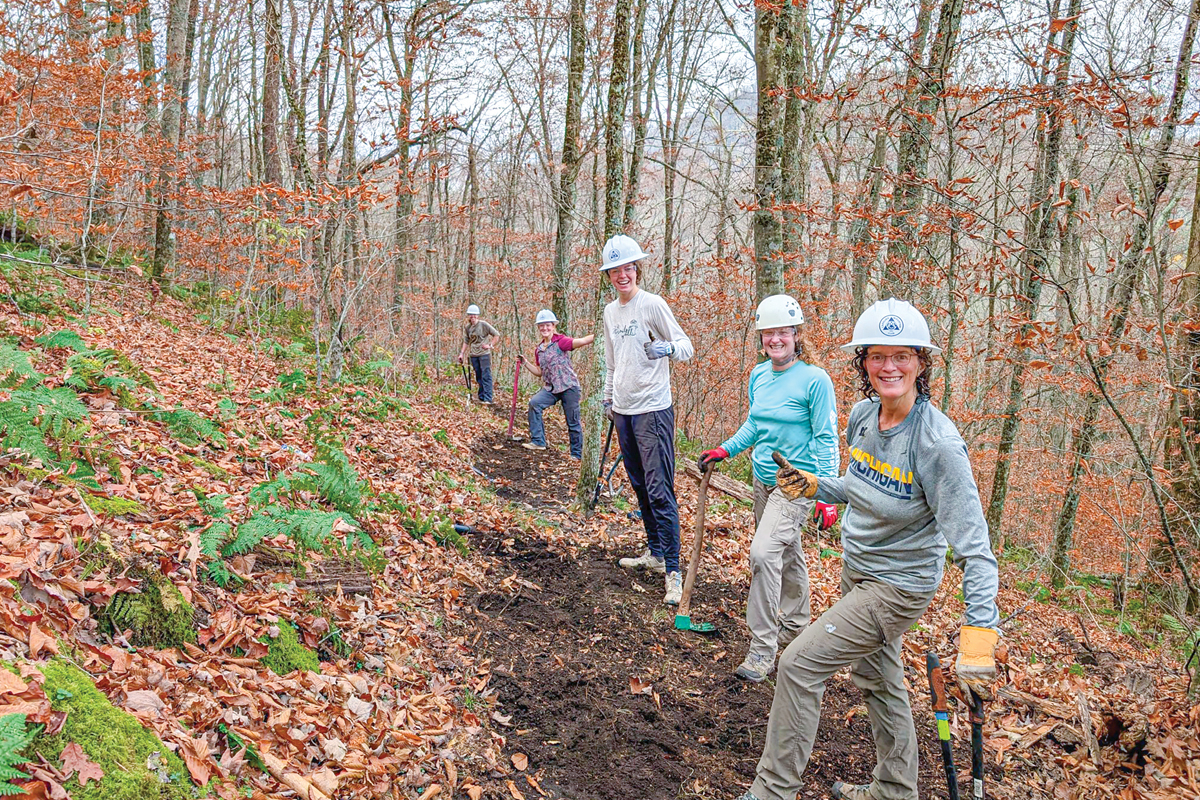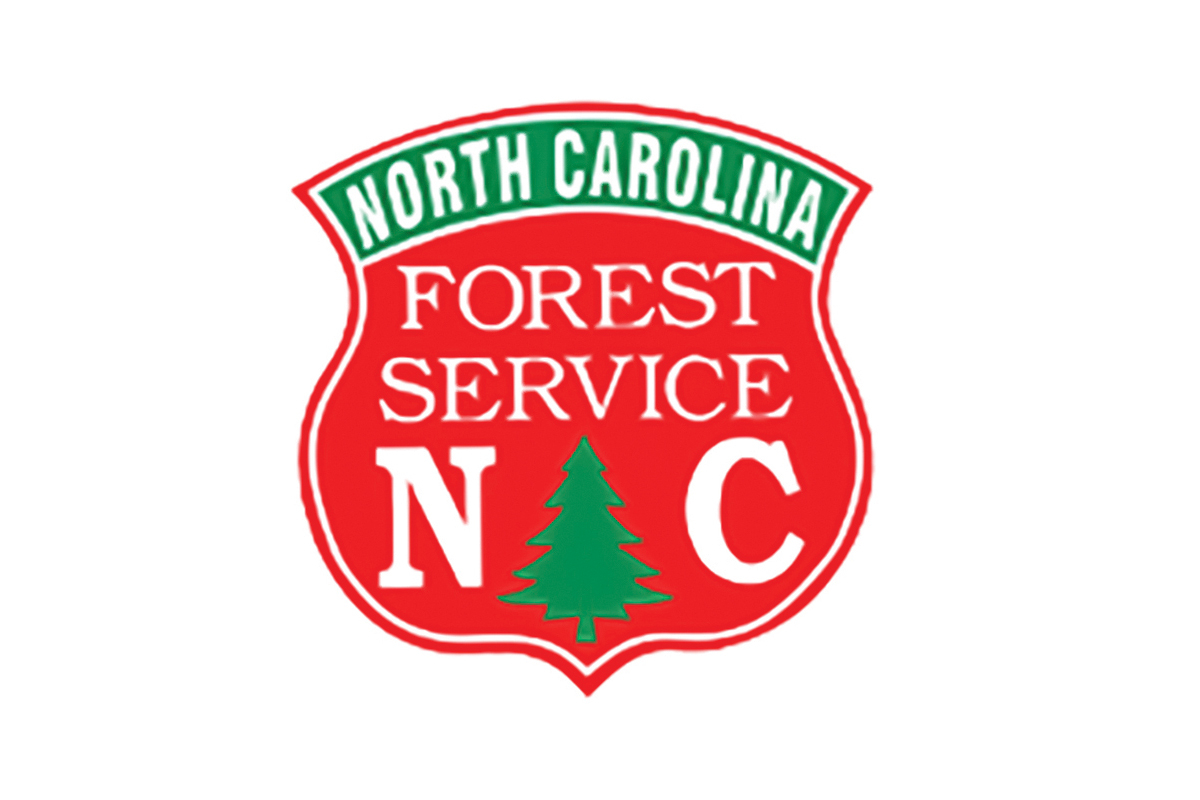Residents weigh in on new Ingles
When Ingles pushes out of its old shell, it’s new home will bring new options to customers, like a stir-fry station, improved produce section and expanded wine and café offerings.
For many local residents, however, the store’s current incarnation is already an asset to their regular shopping routines, and any improvements would just be icing on the grocery-buying cake.
Debbie Simpson, a part-time Haywood County resident, said the store surpasses what the Publix in her part-time Florida home has to offer.
“Basically, I like the store the way it is,” said Simpson, adding that if she had to pick an area that could be stepped up, “maybe more international food” would be the way to go.
James Rich concurred with Simpson’s assessment. The Waynesville rock mason said he couldn’t find a complaint or even a suggestion to proffer for the store. Rich was put on babysitting duty, pushing a grinning, stroller-bound baby around the produce section while his wife added to an already-full cart, a usual family ritual, he said.
“You can’t make it much better than they already have,” Rich said.
Constance Ebert and her husband Millard, speaking from frozen foods where they were eyeing a bag of canary yellow banana pops, said they were pretty pleased with the Waynesville store, but Constance was able to enumerate a few suggestions for improvements.
“I think demonstrations that show how you can prepare things would be great,” Ebert said, and though she said she was pleased with the store’s cleanliness, she’d love some more healthy options, a more Fresh Market feel.
For her part, Waynesville native Dianne Pass gave the supermarket a glowing review as well, and she was pretty excited to hear some of the improvements coming the store’s way, especially the landscaping plans.
“I love this store, I can’t imagine it any other way,” said Pass a twice-a-week patron of the store, “but it’s such a beautiful area, the trees would be great.”
Town aldermen were on board with that, too, lauding the choice to add some flora to the storefront. There was some dispute about tree type, but in the end, the board was pleased by the corporation’s efforts.
“I really appreciate the fact that Ingles has been willing to make this much of an investment in shade trees and landscaping in this parking lot,” said Alderman Elizabeth Feichter.
The changing face of Haywood County: in the middle of everything
For Darcy and Kevin Sisson, living in Waynesville makes perfect sense.
She works in manufacturing in Asheville, his employer is Swain County’s Nantahala Outdoor Center. Waynesville offers the couple a central location, a town large enough to have an active civic and social life of its own, and quality schools for their kids. Throw in lower tax rates than one finds in Buncombe County, and you have the ideal locale for such a family.
The couple and their three children represent a growing segment of the population in Haywood County, according to Mayor Gavin Brown and Mark Clasby, Haywood County’s economic development director. Haywood County is, more and more, becoming a bedroom community.
Last month, Brown and Clasby pinpointed the change during a meeting of the county’s Economic Development Commission. And in doing so, additionally pitched the idea that “bedroom community” should no longer carry the stigma the words once did.
Commute becomes part of day
“To be honest with you, it’s worked out better than I thought,” said Darcy Sisson, noting that she’s started using the commute time to make calls for work or catch up with friends. “They always know between five and six, I’m usually in the car,” she said.
Sisson emphasized that she and her husband might work elsewhere, but Waynesville is home. And for them, that doesn’t just mean the place where you lay your head at night.
“We try to be involved in the community,” Sisson said. “We have our friends there, we belong to the Haywood Fitness Center and things like that, we do a lot of stuff downtown. That’s really where our life is.”
According to statistics compiled by the Employment Security Commission, three quarters of Haywood County residents commute outside the county to work. This doesn’t exactly classify the whole of Haywood County as a textbook bedroom community, but with three quarters of residents working elsewhere, it does make the county into at least a partial bedroom community. If true, this means Haywood County faces different challenges than the county has faced before.
Brown sees it less in terms of sheer statistics, and more as a social descriptor of the community’s changing face.
“It’s not a number so much as a description of what your community is,” said Brown. “It’s just more a reflection of the way our economy has changed in the world and in the United States in general. Some people would see it as bad, I know. And they do. And there’s logic to that.”
But he sees this as an opportunity to engage people who have, for whatever reason, chosen to live in Haywood County, even though their work is elsewhere. Doesn’t that make them prime candidates for a larger degree of community involvement and devotion, the fact that they’ve chosen to call the county home?
Where the action happens
Haywood County is centrally located, right in the heart of big employers in Cherokee, Sylva and Asheville. So if people choose to live here, the challenge lies in getting them to engage in the community, have a stake that will keep them there, even if their out-of-county job changes.
“It’s the stability factor that’s important to me,” Brown said. “The last thing you want is some generic community that people are moving in and out of all the time.”
The key, he said, is to provide services and quality-of-life options that entice people to come and stay because they love the community, not because they work in it.
So things such as local art groups, quality health care facilities and better options for fitness, dining and civic life are all an important part of getting commuters to put down roots.
“If we provide those kinds of things, then people choose to not make their job the primary thing in their life,” Brown said.
Gateway Club turns up the heat at Fire & Ice Star Chef competition
Culinary talent throughout Western North Carolina gathered to compete in a single-elimination culinary skills recipe and preparation contest during the Fire & Ice Winterfest this past weekend.
Sweet potatoes, pork tenderloin and Chayote squash were among the ingredients given to contestants in the Haywood County Chamber of Commerce’s Star Chef competition.
Area Chefs & restaurants submitted recipes using the star ingredient of sweet potatoes prior to the competition. Recipes were then reviewed by a panel of professional chefs and food critics, and the top four were invited to the Waynesville Inn to prepare and present their culinary masterpiece.
The top two finalists, the Gateway Club & Maggie Valley Club, were selected by a judging panel to compete in a 45-minute star chef cookoff. Each finalist was given a mystery box of ingredients to prepare their best interpretation of the “Stars of the NC Farms”.
The Gateway Club won the “Top Chef Award” for their braised pork tenderloin with Chayote squash and couscous.
Something to hold on to: Master furniture maker inspired by handmade revolution
John Gernandt loves the word tactile. It’s not so much the word, really, as the whole concept. People, he says, love to pet things. It is in our nature. We are, by default, a touchy species.
He is saying this as he sits on a low wooden stool, running his fingers along the pock-marked texture carved into the sides. See, he says, it’s tactile, human.
Gernandt is a master carpenter, a third-generation furniture maker, and the piece he’s sitting on is one of his own, on display in his downtown Waynesville gallery, Textures on Main.
His creations are dotted around the gallery, and though they’re all different, most are easy to pick out as being crafted by his hand. The workmanship is excellent and has built him a reputation in the world of custom furniture-making. His portfolio includes works done for millionaire clients, as well as some done for locals. He’s not an elitist in that sense, as evidenced by his belief that furniture – even art – should be touchable.
He’s a strong proponent of the handmade revolution, and speaks with passion about populating modern life with objects made by actual craftsmen. He counters what he sees as the myth that handmade or custom is necessarily more expensive.
“My furniture doesn’t cost a dime more than if you go to a nice furniture store, and it can’t, because that’s my market,” says Gernandt.
There is, he says, something to be said for having and using things that someone has poured time and thought and talent into.
“When you sit down at a table where there’s handmade dishes and glasses and chairs, it’s a good feeling,” he says. “And it’s heirloom furniture.”
And that’s what he’s in the business of building: heirloom furniture.
He has a workshop in the basement of his Main Street gallery where he uses only domestic woods to craft his works, 80 percent of which are commissions.
There are curving templates of every shape and size hanging on the walls of the workroom, which he proudly says are all what he calls human curves. They are all modeled after curves one might find on actual humans, none are made by protractors or compasses. “I think they’re just stale,” he says of such mechanical curves. And that’s part of what Gernandt says is appealing about his work. It’s human, tactile.
As an example, he points to a particular table back upstairs in the gallery. Its legs have a slight outward slant which, he says, came from the person who commissioned the piece. He had her lean forward as her husband traced the curve of her lean, and that is the curve of the table. There are examples of that everywhere, he says.
In terms of strict classifiers, his style is contemporary, and that is what he markets himself as. But he doesn’t see contemporary as a strict genre to which he must conform. He is adamant that contemporary is the culmination of all traditions that have come before, and he takes great pleasure in studying them then incorporating them into what he does today.
“I enjoy studying furniture history,” says Gernandt, pointing out a King Louis ankle wrap on a cabinet standing against the wall. That’s part of the fun, incorporating elements of history into new creations.
Gernandt’s own personal furniture-making history started early, age 9 to be precise. His grandfather was a furniture maker, and he loved working with the older man. As a young boy, he approached him with the notion that he, too, would like to make furniture for a living. His grandfather considered and pointed the young Gernandt to an unsanded chair.
“’There’s a chair down there, sand that,’” he said. “‘It’ll take you eight hours a day for five or six days.’” And when he completed the job, his grandfather awarded his stamp of approval, conceding that maybe his grandson had what it took to make it a career.
He did do a stint away from the craft for a while, getting a degree in education before returning to furniture artistry for good in his twenties.
Then he and his wife Suzanne, a textile artist, moved to Western North Carolina with their children because, he says, it’s at the heart of craftsman culture in America.
And business has been good for them, though, of course, not perfect.
He is hopeful that there will always be a market for quality crafted pieces like his, pieces that have a story and a history.
He’s very excited about the idea of apprenticeships to keep the craft alive, and hopes that what he’s able to pass on to future furniture makers is the idea that what makes them important and unique is their creativity.
He’s aware that, in terms of cost, he can’t compete with flat-pack factory furniture, but there is something more valuable, he says, about creativity and craft.
“I think people are starting to understand the importance of creativity in their life,” says Gernandt. “You feel better about your life, and there’s value in that. There’s real value in that.”
To see more of the work of John and Suzanne Gernandt, visit www.texturesonmain.com.
A place where two worlds collide head-on
By Scott Muirhead • Guest Columnist
Frog Level is what remains of the golden age of the railroads, the age when bulk goods, travelers and mail were carried exclusively by train, when neither interstate highways nor 18-wheelers existed. Some might believe that age a better time, more romantic, more soulful, and I don’t know about that.
But it is impossible not to believe that 80 or 90 years ago there was something magical about a lone train whistle calling to a small town deep in the mountains. The train might have come from Winston-Salem, or even Raleigh itself, and it might have been headed anywhere! The train always stirred excitement with its arrival onto the Depot Street crossing. Its presence was reassuring; and if not exactly sacred, it was something, something larger than life.
I don’t suppose any train ever did depart that was not loaded with the expectations of the hopeful, and with the regrets and longing of a whole lot of the rest left standing in its ephemeral cover of smoke and steam. Trains took people away, even those who stayed behind. And nothing then was ever so quiet as the town when the train had departed.
Trains must have been revered. Their roaring and chugging and squealing and rumbling was big, sure enough, but the trains represented something even bigger, really big, bigger than the town, bigger even than the mountains themselves. Was it progress? Was it industry? Was it power? Maybe, probably it was. But there was more. With an ear-piercing whistle blast announcing the approach into town, and then with the click-clacking of caboose wheels as they eclipsed time and space and disappeared, the great steel leviathans spoke to us, telling us unerringly that beyond the horizon there was something more.
Then center stage, Depot Street now is forlorn. The glamour of travel, of new shipments for the department store, of the unceasing energy of commerce, most of that has gone away. The brick buildings remain, but they seem sad for the most part, as if aware they are just mere remnants of another time, faded from this world. Today the freight trains that roll into town are infrequent, and they possess no mystery, just sand for the concrete plant, and lumber for the lumber yard. Trains are incongruous in a high-tech world, mere plodding nuisances to drivers in a hurry.
Frog Level is where two worlds collide, one the lunatic fringe of wastrels, the other a loose set of ambiguous rules, variously interpreted. Above Frog Level is the contemporary commerce of Main Street with all its many shops and subsidiaries, places like the county courthouse and the ubiquitous insurance agencies. Then, two blocks below Main Street is the realm of the wrong side of the tracks, where the complexities of life are less well examined. There you will find the town waver. Anytime, most any day, he’ll be somewhere between the bridge and the car wash, ambling and lurching and punching the air with his open palm at each passing car and truck.
What day is of no more importance to him than the time of that day. All that matters are the cars and trucks passing through Frog Level, his part of town, his Waynesville. It’s where the soup kitchen feeds the winos and the junkies and the ne’r-do-wells; where the chemical company mixes and brews its industrial potions; where the old has been outpaced and outmaneuvered by the new. It is that urban stretch people drive through to get to somewhere, because for them Frog Level is nowhere.
But it is a real place of real events, where can be seen, for instance, the dashed hopes and dreams of speculators emblazoned on the store fronts of stores that never opened. For a couple of years about a decade ago Frog Level had been Waynesville’s real estate bonanza of the post-Vietnam era. Deals were struck, properties were traded and sold, leases were drawn and signed and initialed. The Smoky Mountain Railroad was coming to town, bringing tourists and their money, and the prosperity of would-be merchants was just around the bend.
Then the railroad didn’t come, and now the storefronts are boarded up or blacked out, and all those hopes and dreams have moved on down the line.
Only the soup kitchen and a coffee shop seem to prosper in the microcosm that is Frog Level. The electric motor shop and the cabinet maker and the used appliance emporium are still around, but they have been there through 30 years or more, unaffected by boom or bust. Meanwhile the bridge over Richland Creek, just down from the cabinet shop, serves as the rooftop of a communal campground where the winos take shelter from the weather and the world. They’ve got themselves a regular cardboard condo complex down there; and nowadays they even share a cell phone. Such is the domain of the smiling waver.
It’s doubtful the man knows where he is, surely who or why he is; or whether he knows society has pegged him the crazy guy who waves at everybody. And perhaps that is why he always smiles. He smiles because of all the things he does not know. And maybe he smiles at the irony residing in the fact that so much of what he doesn’t know doesn’t matter anyhow. It implores us to ponder the question: Why do we smile who know so much? The waver sure looks happy, not to know so much.
I would bet that most people feel sorry for the waver, thinking him deprived. I don’t. When I cross over the tracks and pass him by, him standing there smiling with his open palm high in the air, I am usually enroute to a place I am compelled to go. Him, he doesn’t have to go anywhere; but I do, and I am headed to the courthouse to pay another tax on my little bundle of burdens; or to one of the insurance agencies to pay a premium to protect the little bundle; or to one of the banks to deposit the imaginary wealth of a paycheck that seems ever too small.
It’s just one of the drawbacks to prosperity, but riding with me usually are my two boon companions, Worry and Stress. I never see them hanging out with the waver, but they are well known to most all of us of the dubious fortune to be enlightened and aware and playing by all the rules.
Henry Thoreau said, long ago, that he pitied the peasant trudging beneath the weight of all his worldly possessions bundled on his back; but Thoreau did not pity the man because he had so little to his name. He pitied him because he had so much to carry.
The Frog Level waver has no bundle on his back, and he smiles and he smiles. Maybe he smiles and waves to encourage us, us who perhaps he pities.
(Scott Muirhead is a builder who lives in Maggie Valley.)
HART studio season begins with ‘Life in the Theatre’
The Haywood Arts Regional Theatre will open its 2011 winter Studio Theater Season with a bit of backstage humor and some twists for the audience when “A Life in the Theatre” debuts on Jan. 7.
The comedy by David Mamet will feature HART Executive Director Steve Lloyd and Asheville actor Casey Morris in the play’s two roles under the direction of Julie Kinter. Mamet, one of modern theatre’s most celebrated playwrights, is known for his salty language which is toned down in this play, but audiences should be aware that the show still contains some adult language.
“A Life” follows two actors, a seasoned veteran and a new rising star in a resident company as they prepare and perform in a number of scenes Mamet has created to poke gentle fun at some of theatre’s sacred cows. There is a Chekov scene, showcasing the tedious Russian dramatic style, a lifeboat scene, an operating room scene, a Civil War scene, and a French Revolution scene that is obviously taking a jab at “Les Miserables.” On stage and off things break down and the two actors grow together then apart. For “A Life in the Theatre” audiences should expect some surprises. The first when they enter the performance space.
The HART Studio Season features six plays in just 12 weeks and is one of the highlights of the winter arts scene. Productions regularly sell out and runs are often extended. The Feichter Studio is HART’s second performance space, seating only 60 people and reservations are recommended to insure patrons get a seat.
Make a reservation by calling the HART Box Office and leaving a message. Calls are not returned unless no tickets are available. The show will run Friday and Saturday, Jan. 7-8, at 7:30 p.m. and Sunday, Jan. 9, at 3 p.m. Tickets are $8 for all adults and $5 for students, general admission. To make reservations call the HART Box Office at 828.456.6322. All performances are in the Feichter Studio Theatre, 250 Pigeon Street, Waynesville.
Waynesville Inn to play host to second-annual Winterfest
Haywood County residents looking to brave the ice and leave their firesides this January can find an afternoon of respite from the winter in Waynesville’s second annual Winterfest.
The festival, themed Fire and Ice, is hosted by the Haywood County Chamber of Commerce and will be held at the Waynesville Inn and Country Club on Jan. 15 from 3-7 p.m. The event will feature an ice carving competition, a fashion show, a dog sledding race to benefit local animal charity Sarge’s, and an Iron Chef-esque cooking competition featuring chefs from around the region.
The idea is to make the county, and Waynesville in particular, a year-round destination, not just a summer and fall spot. Currently, there’s not much besides a bit of local skiing to draw visitors in the coldest months, but the chamber’s executive director CeCe Hipps wants Winterfest to be one of the first steps in changing that.
“The main reason that we were doing the Winterfest is to bring people into this area in the winter time to make it a four-seasons destination,” said Hipps. “Our hopes would be that in 20 years from now, it would be the size of the Apple Harvest Festival.”
With that ambitious goal in mind, Hipps and her crew have made a few changes to the festival this year, the most notable being a cut in ticket prices. Pre-purchased adult tickets will be just $10, while they go up to $12.50 at the door.
That buys admission to the festival but doesn’t pay for anything inside like food, drinks and souvenirs. It will pay for watching things like the ice carving competition, one of last year’s festival highlights and a sight to behold as skilled chainsaw artists go head-to-head carving up blocks of ice into glistening sculptures. The artists, Hipps said, come from around the region, including Asheville artist Jeff Pennypacker.
Another new draw at this year’s event will be Star Chef competition, which will feature eight as yet unnamed Western North Carolina chefs who will compete for a spot in the final two-chef competition. Competitors will be picked in the days leading up to the event based on their submission of a recipe that included two cups of mashed potatoes.
A fashion show and dog-sled race, open to all dog owners and their furry companions to benefit Sarge’s, and a fashion show will round out the afternoon.
Hipps said she realizes that coming out on a chilly winter afternoon isn’t exactly what a lot of people have in mind, but she hopes that residents and visitors alike will bundle up and come out for the fun.
“The biggest thing is I just want people to give it a chance, give it an opportunity. It’s in the afternoon so it doesn’t mess with your evening activities,” she said.
While the festival will be more an afternoon of activities than a full-blown, vendor-filled festival like autumn’s apple event, Hipps said that’s what they’re aiming for in the future. There will be one candle maker there, and the ice carving itself is a spectacle to see. All told, it takes the artists two hours to coax their creations from the ice, and it’s an entertaining process. But, she said, in future they hope to add more events and attractions to fill out the day.
“This is the start of it, but we anticipate that it will grow, not only from population but from activities and events that go on as well,” said Hipps. “We have some ideas for future expansions, and Waynesville Inn is great location.”
For more information call the Haywood County Chamber of Commerce at 828.456.3021 or visit www.Haywood-NC.com.
Board holds off on land use vote
The Waynesville Planning Board said this week it will hold off on adopting a major update to the town’s land use plan until February at the earliest, and will delay voting even then if it thinks citizens still want time to digest the plan and offer suggestions.
“I will say that people have told me that if we vote at this meeting it would prevent some from commenting,” said planning board member Jon Feichter at the Dec. 20 meeting. “I would be in favor of waiting until at least Feb. 21 to vote.”
Other planning board members agreed to wait until then at the earliest.
“I think we can tentatively schedule it for then, but it can wait until later if that’s what we need to do,” said board chairman Patrick McDowell.
Town Planning Director Paul Benson also said that there should be no rush to adopt the revisions.
“It is my recommendation that you vote when you feel comfortable with it. Tonight would be too early,” said Benson.
Benson told board members he would like them to delay voting and take public comment at its next couple of meetings.
The updates to the town’s land development standards have been in the works for more than a year. Waynesville hired a consulting company that has been working with a town committee to update the land-use standards that were originally adopted in 2003. Nearly 40 meetings have been held, and result of that work was presented to town citizens at two public meetings in late November and early December.
Benson prepared a package of all the comments for the planning board, but he said two issues raised by the public stood out: one, criticism of the revision that will remove the mandate that parking be on the side and in backs of buildings in commercial areas; and two, complaints about the new plan’s allowable density and height.
The board did not discuss any changes to the original proposal in response to public comment from the two public meetings.
Feichter did bring up one problem that he said might need to addressed: the stipulation that redevelopment of existing structures did not have to meet the new standards as long as the revision was to less than 50 percent of the existing structure. He said some could take advantage of this if there was not a time limit put in the regulations saying how long a period there had to be between renovations.
Benson suggested that saying a year must pass between renovations would likely solve this problem, but the board did not adopt any change.
New regulations are a compromise
Editor’s note: This letter was written by Waynesville’s planning director in response to Mary Lamb’s letter above.
Dear Ms. Lamb
Thank you for copying me on your message to Mayor Gavin Brown. I can’t speak for the mayor, but I was frustrated that most of your questions seemed to be aimed at attacking our process rather than genuine questions to gather information about the draft ordinance. Many people have worked very hard to produce the product that you have attacked even before understanding what it contains. My concern at both community meetings was that your insistent, repetitive and argumentative statements were dominating the meeting to the exclusion of comments from other citizens that pertained to the actual content of the ordinance.
Our steering committee was never intended to be demographically balanced. The criteria for selection was experience with the Town’s development regulations. All were appointed directly or indirectly by your elected representatives. All meetings of this committee were open and members of the media did occasionally attend.
As you have the opportunity to review the draft ordinance, I am hopeful that you will appreciate some of the changes even if you don’t agree with others. Please let us know what you don’t agree with, and how in your opinion it can be improved. That is the type of feedback that will be effective in making the ordinance better.
I’m sure you realize that all development ordinances represent compromise, so it’s unlikely that everyone will be completely pleased with the result of the revision. However, the objective of this process as I see it is to produce a set of development regulations that are more user-friendly and more importantly will make Waynesville a better place.
Paul Benson
Waynesville Planning Director
Residents need time to review zoning changes
To the Editor:
Like so many other young couples, my husband and I felt so blessed when he landed a job in this area five years ago and we were able to move and start a family in Waynesville. We had looked at living in Sylva, but immediately were attracted to the historic character and charm of this dear town and seriously impressed with the well-thought out planning of the downtown, where we currently live.
This interest in being a part of a vibrant, beautiful community led me to attend a meeting hosted by Paul Benson, planner for the town of Waynesville, on Tuesday in which the town’s newly drafted land development standards were presented to the public. Benson explained that over a more than two-year period, a committee appointed by our respected town board reviewed the old land development standards, coming up with a completely new document to be enacted into law — a document that would entirely replace our current standards.
Mr. Benson said that only 10 percent of the current law would effectively be changed; however, the changes he discussed I found to be on very critical issues (parking, setbacks, landscaping, to name just a few). Many of these changes could alter the originally planned landscape, making it appear more and more like suburban strip malls and big box centers of larger cities, not the quaint mountain town we love and that tourists love to visit.
Residents wishing to make changes to improve and protect the character of their neighborhoods have been told that this review process would be their opportunity to organize and make changes. But even after news outlets have advertised the public meeting times, the public still needs ample time to review, digest and discuss the more than 300-page document that is currently the law, along with the new 200-plus page document being proposed to supersede it. These documents are written in entirely different forms, making it very time-consuming to compare and contrast them.
Currently, neither Mr. Benson nor his committee have offered the public an easy to read list of all changes from the old law to the new—only summaries they wish to highlight and that are admittedly incomplete. They are putting the burden of review on the public, a process that again is complicated and lengthy.
Currently, the town planning board is set to begin discussion and possibly even vote on the new standards Monday, Dec. 20. This would only allow concerned citizens two and a half weeks (during the Christmas season) to review it. I would urge interested citizens to contact the Town Board and urge them to delay all voting on this plan until at least March to allow interested citizens time to read, meet and develop their own concerns for consideration.
What is the vision of Waynesville’s residents for their future? A handful of men only have spent two years revising the original standards which were developed and adopted (in 2003) with both men and women actively involved. Allowing folks a couple of months to give feedback is not too much to ask. The standards adopted by the town greatly affect the beauty, character, economic development and general sustainability of our community.
What you can do to help:
1. Email or call the Waynesville Aldermen, the chair of the Planning Board and the Town Planner and ask them in your own words to postpone any vote on adopting the Land Development Standards until at least March.
Mayor Gavin Brown, This email address is being protected from spambots. You need JavaScript enabled to view it., 828.452.2491
Alderman Gary Caldwell, 828.456.3138
Alderman Elizabeth Feichter, This email address is being protected from spambots. You need JavaScript enabled to view it., 828.456-6918
Alderman J. Wells Greeley, This email address is being protected from spambots. You need JavaScript enabled to view it., 828.456.7288
Alderman LeRoy Roberson, This email address is being protected from spambots. You need JavaScript enabled to view it., 828.456.7142
Town Planner Paul Benson, This email address is being protected from spambots. You need JavaScript enabled to view it., 828.456.2004
Planning Board Chair Patrick McDowell, 828.508.4932
2. Attend the Waynesville Planning Board meeting at 5:30 p.m. on Monday, Dec. 20, in the upstairs room of the new downtown police station to ask the entire planning board to postpone their critical vote on this issue until at least March.
3. Forward this letter and info to anyone Waynesville residents you know who are concerned with Smart Growth, historic preservation and maintaining the character and charm of our community. Post information on any Facebook or other social networking site you regularly use to contact your Waynesville friends, family, co-workers and neighbors.
4. Contact me with your other ideas on how we can work fast to take advantage of this window of opportunity for making positive change in our community. A small group of concerned citizens is currently forming to carefully review the new plan and we would love your help.
Mary Alice Lamb
Waynesville






















